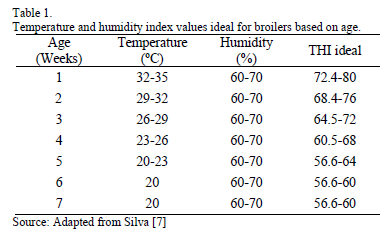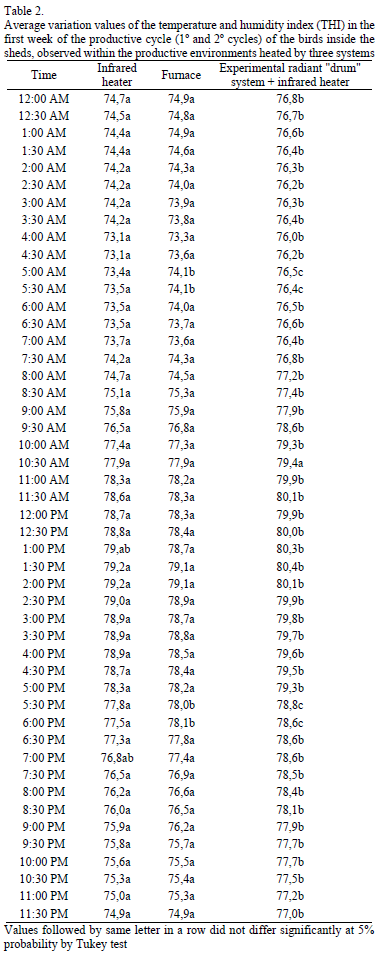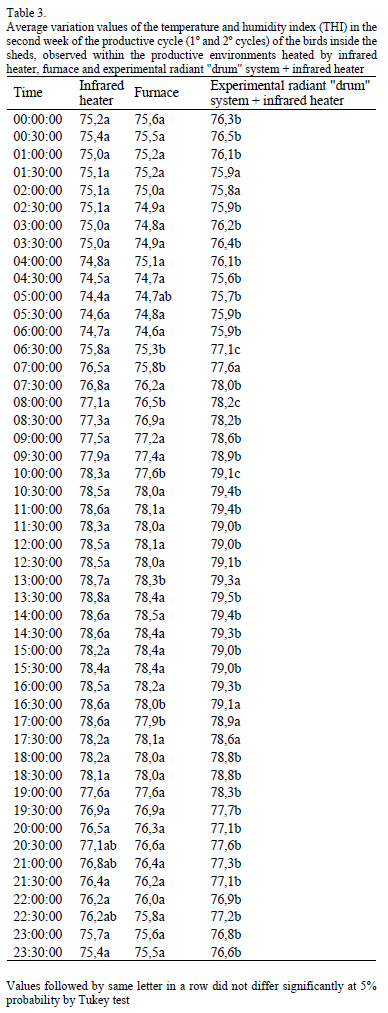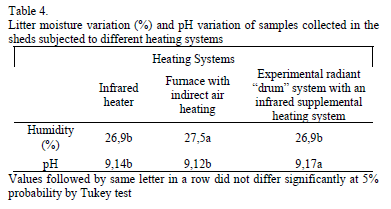Serviços Personalizados
Journal
Artigo
Indicadores
-
 Citado por SciELO
Citado por SciELO -
 Acessos
Acessos
Links relacionados
-
 Citado por Google
Citado por Google -
 Similares em
SciELO
Similares em
SciELO -
 Similares em Google
Similares em Google
Compartilhar
DYNA
versão impressa ISSN 0012-7353
Dyna rev.fac.nac.minas vol.81 no.185 Medellín maio/jun. 2014
https://doi.org/10.15446/dyna.v81n185.35762
http://dx.doi.org/10.15446/dyna.v81n185.35762
Effect of heating systems in litter quality in broiler facilities in winter conditions
Efecto del sistema de calefacción en la calidad de la cama de galpones de pollos de engorde en condiciones de inverno
Ricardo Brauer-Vigoderis a, Ilda de Fátima Ferreira-Tinôco b, Héliton Pandorfi c, Marcelo Bastos-Cordeiro d, Jalmir Pinheiro de Souza-Júnior e & Maria Clara de Carvalho-Guimarães f
a Unidad Académica, Universidad Federal Rural de Pernambuco, Brazil, vigoderis@uag.ufrpe.br
b Departamento de Ingeniería Agrícola, Universidade Federal de Viçosa, Brazil, iftinoco@ufv.br
c Departamento de Ingeniería Agrícola, Universidad Federal Rural de Pernambuco, Brazil, pandorfi@dtr.ufrpe.br
d Departamento de Zootecnia, Universidad Federal de Acre, Brazil, mbcordeiro@gmail.com
e Departamento de Ingeniería de Producción, Universidad Federal de Itajubá, Brasil, jalmirpinheiro@yahoo.com.br
f Departamento de Agronomia, Universidad Federal del Jequitinhonha y Mucuri, Brazil, mariaclara.guimaraes@ufvjm.edu.br
Received: November 18th, 2012. Received in revised form: January 26th, 2014. Accepted: April 25th, 2014.
Abstract
The objective of this research was to evaluate the influence of heating systems in poultry houses on the characteristics of the psychrometric air and litter quality (moisture and pH) in winter conditions in the western Santa Catarina State, Brazil. The experiment was conducted in three properties of the integrated poultry farms Perdigão with three similar sheds, equipped with different heating systems (infrared heater –; furnace with indirect air heating; radiant experimental "drum" system with an infrared supplemental heating system). Values were obtained continuously from three median points of each facility at the same height of the birds - measuring the relative humidity and air temperature - for the determination of THI. For the analysis of litter humidity and litter pH, four samples were collected at four different points in each shed every two days during the period in which the heating systems were used. In the poultry houses, the THI values detected were within the range considered adequate for the development of animals in their first week, respecting the requirements of animal welfare; In their second week of life, excessive values of THI were detected, featuring discomfort and energy waste. In environments heated by the evaluated systems, the litter moisture content is maintained a suitable value according to the literature, however, the pH values of the litter samples collected in the production environments showed a basic environment, making it suitable for growth of ammonifying bacteria.
Keywords: broiler, poultry houses, humity, pH
Resumen
El objetivo de este trabajo, fue evaluar la influencia de los sistemas de calefacción en galpones avícolas, las condiciones psicométricas del aire interno y en la calidad de la cama (humedad y pH), en condiciones de invierno, en el oeste del Estado de Santa Catarina. El experimento fue desarrollado en tres propiedades avícolas integradas en la industria Brasilera Perdigão, en núcleos con tres galpones similares, equipados con diferentes sistemas de calefacción (Campanas infrarrojas a gas, hornos a leña de calentamiento indirecto del aire e intercambiadores de calor por radiación con calentamiento como suplemento de las campanas infrarrojas a gas). Valores de la humedad relativa y la temperatura del aire fueron obtenidos continuamente, en tres puntos de medida de cada instalación al nivel de las aves, para determinar el índice de temperatura y humedad (ITH). Para los análisis de humedad y pH de la cama, fueron colectadas cuatro muestras en cuatro puntos diferentes en cada galpón, cada dos días, durante el periodo en que fueron utilizados los sistemas de calefacción. Los sistemas de calentamiento en campanas infrarrojas a gas y el sistema conjugado de intercambiador más campanas infrarrojas a gas, proporcionaron valores de humedad de la cama, inferiores a los observados en ambientes calentados por el sistema con horno a leña. En los aviarios calentados por los sistemas de campanas a gas y el horno a leña, los valores de ITH, se mantuvieron en una franja de confort para el bienestar de las aves, pero en el sistema conjugado con más campanas a gas, fue detectado estrés y desperdicio de energía. Para todos los sistemas de calentamiento los valores de humedad de la cama se mostraron adecuados, sin embargo, los valores del pH de las muestras de cama, colectadas en los ambientes de cría, evidenciaron un ambiente básico, tornándolo propicio para el crecimiento de bacterias amonificantes.
Palabras clave: pollos de engorde, galpones avícolas, humedad, pH.
1. Introducion
The importance of broiler chicken production in Brazil is growing both on a national and international scale, requiring more efficient and intensive production systems to produce greater yields (Saraz [1]).
The optimum productivity is achieved with the use of energy for growth, while keeping the birds in a comfortable temperature range, without having to expend energy to compensate for the cold or hot temperatures (Abreu [2]).
The birds maintain constant body temperature when the temperature ambient is thermoneutral (WELKER [3]). However, broilers, in their initial phase, are very sensitive to low temperatures, which may negatively affect their development, leading to huge financial losses, especially in conditions of harsh winters.
Heat energy is added to the facilities from the metabolic production of birds, lights and motors, roofs and walls (depending on the insulation), and the fermentation of excreta. However, providing extra heat for birds is essential in the early stages of life when there is a risk of stress due to a cold environment. Their first two weeks of life are the most critical because errors at this stage can not be corrected in the future, thus affecting the final performance of broilers (NILIPOUR; BUTCHER, apud CORDEIRO [4]).
Various indexes express the animal comfort in a particular environment. In general, two or more climatic variables are considered, however, there are also other variables, such as metabolic rate, insulation type, etc (BAÊTA & SOUZA [5]). THOM [6] developed the Discomfort Index, later called Temperature and Humidity Index (THI). This index was obtained by simple linear fit applied to a temperature range of dry bulb and wet bulb, expressed in eq. (1) (BAÊTA; SOUZA, [5]):

Table 1 shows the temperature and humidity index values ideal for broilers based on age.
The heating systems that have been most commonly used in semi-acclimatized facilities for broilers in southern Brazil are infrared gas heater, furnace with direct or indirect air heating and experimental radiant "drum" system (CORDEIRO [4]; VIGODERIS [8]). However, there is little information about the effects of different heating systems on the litter quality.
The broilers produced in Brazil are managed using the litter system. Litter is an absorbent material used on the aviary floor for the broilers production (UBA [9]). According to AVILA [10] and JORGE [11], the litter thickness is between 8 cm and 10 cm, depending on the density established, so that at the end of cycle production, the humidity is between 20% and 35%. Litters with humidity above 35% become plastered, causing discomfort for the birds, affecting the performance and lowering resistance to diseases.
It is known that ammonifying bacteria (Bacillus subtilis, B. cereus, B Megatherium, Proteus, Pseudomonas, Escherichia coli, etc.) increase both the manure pH and the concentration of ammonia in and around the poultry houses. The residue of broiler contains 5 kilograms of ammonia per ton while for other adult birds it contains 3.5 kilograms per ton (BUCKLIN apud IVANOV [12]). In relation to these factors, there have been various adverse effects, such as increased food intake, decreased growth rate (GRISHCHENKO apud IVANOV [12]; FOUBER apud IVANOV [12]; KAITAZOV e STOYANCHEV apud IVANOV [12], environmental pollution (MIJS apud IVANOV [12]), increased mortality and respiratory diseases (MARDAROWICZ apud IVANOV [12]; BRADBURY apud IVANOV [12]; CARRIER apud IVANOV [12]) and development of pathogenic and immunosuppressive bacteria (BYRD apud IVANOV [12]).
In acidic environments (pH <6) the ammonifying bacterial growth is inhibited, and when pH is below 5, the conditions are unfavorable for the development of Salmonellae (Byrd, 1999 apud Ivanov [12]). Acidification of the litter reduces the negative effects of high concentrations of ammonia and bacteria by inhibiting ammonifying bacteria and neutralizing the ammonia. In relation to this, various substances have been used: aluminium sulphate, ferric sulphate, phosphoric acid and acetic acid and antibiotics (Medeiros [13]). For this reason, the pH influences the quality of the bed.
Therefore, this research was conducted to evaluate the influence of heating systems in broiler houses in the thermal environment and litter quality.
2. Material and Methods
The research was conducted on three integrated properties of a poultry farm with three similar sheds, equipped with different heating systems used for the production of 18,500 Cobb females, for each of the nine sheds evaluated, with an average weight at slaughter of 1.450 kg, for two flocks in the Videira city, during the winter between June and October. The city of Videira is located in the state of Santa Catarina, at an altitude of 750 m, latitude 27°00'30" South and longitude 51° 09'06" West. The climate Köppen's classification is Cfb, with average annual temperatures between 16oC and 17oC. Three different heating systems were evaluated:
- infrared heater;
- furnace with indirect air heating;
- experimental radiant "drum" system with an infrared supplemental heating system.
The sheds are 100 m long and 12 m wide, with polyurethane liner positioned at a height of 3 m from the floor, and the longitudinal axes are oriented East-West. The roof was composed of ceramic tiles with a slope of 30% and overhang of 0.50 m. The side closures were composed of a short wall of 0.30 m high and a metal screen that goes up to the height of the installation ceiling, combined with curtains of yellow polypropylene. All houses received a new 7cm layer of litter made of thick wood shavings. The air temperature and relative humidity was recorded continuously in three median points of each facility, at the height of the birds (10-30 cm, following the growth of animals). Measurements were performed using dataloggers with a sampling period of 15 minutes throughout the experiment for two complete production cycles. The dataloggers had a resolution of 1% (humidity) and 0.1°C (temperature), and an accuracy of 1% (humidity) and 0.1oC (temperature). With the values of air temperature and relative humidity, the temperature and humidity index – THI (THOM [6]) was calculated.
The diets provided to the animals were formulated based on nutrient requirements for different stages of growth and were equal for all systems. For the analysis of litter moisture and litter pH, four samples of 50g were collected in four distinct points in the sheds used for the research, every two days during the period that heating systems were used.
The four samples were homogenized and the moisture analysis was carried out using precision scales. Following the weighing procedure, the samples were dried at 105oC. After drying, the weight was determined in a precision balance. For pH analysis the following methodology was used:
- 10 grams of the samples were weighed and placed in beakers of 100 ml of distilled water;
- The samples were shaken with glass rod and allowed to stand for 30 minutes;
- The value was obtained using a pH meter.
In order to evaluate the thermal environment and the litter quality, a randomized block experimental design with three heating systems was used, in two complete productive cycles. At the beginning of the production cycle new litter was used. The data were subjected to analysis of variance and means tested with Tukey.
3. Results and Discussion
In Table 2 it was observed that poultry houses in the three treatments showed values of temperature and humidity index (THI) within the range considered adequate for the development of animals in the first week of life (72.4 to 80), according to Silva [7]. In the experimental radiant "drum" system with an infrared supplemental heating system, it was detected higher values of THI. The maximum values of THI were found around 01:30pm.
In the second week of housing (Table 3), excessive values of THI higher than the recommended range by Silva [7] were detected, which lies between 68.4 and 76 in the three systems evaluated. Excessive heat can cause animal dehydration and decreased feed intake, and characterize fuel waste. In other periods, the THI values were within the recommended range.
According to the results (Table 3), it was noted that in environments heated by the infrared heater and experimental radiant "drum" system with an infrared supplemental heating system, the litter moisture values were slightly below the environment heated by the furnace. This happens because these systems radiate heat more intensely to the litter than the furnace, whose operating principle is the injection of heated air. But all systems provided a litter humidity value suitable for birds, according to the values recommended by Jorge et al. (1997), which should be between 20 and 35%, showing that environments that provide environmental thermal comfort also provide adequate litter moisture.
Regarding the litter pH (Table 4) of the samples, values higher than 9 were found, featuring a basic medium, making the environment susceptible to ammonifying bacterial growth, which can increase the gas concentration and negatively affect the internal environment production. To mitigate this problem, it is suggested to use various substances, such as aluminium sulphate, ferric sulphate, phosphate, phosphoric acid, acetic acid and antibiotics (Ivanov [12]; Medeiros [13].
4. Conclusion
Regarding the conditions of this experiment and the results obtained, it was concluded that:
- In poultry houses subjected to three treatments, the THI values obtained were within the range considered adequate for the development of animals in their first week, respecting the requirements of animal welfare;
- In the animal's second week of life, it was detected excessive amounts of THI, featuring discomfort and energy waste;
- In environments heated by the test systems, the litter moisture content is maintained at a suitable value according to the literature
- However, the pH values of the litter samples collected in the poultry houses showed a basic environment, making it suitable for growth of ammonifying bacteria.
References
[1] Saraz, J. A. O., Tinôco, I. F. F., Rocha, K. S. O., Martins, M. A., De paula, M. O. Modeling and experimental validation to estimulate the energy balance for a poultry house with misting cooling. Dyna, vol. 78 (170), pp. 167-174, 2011. [ Links ]
[2] Abreu, P. G., Abreu, V. M. N., Coldebella, A., Jaenisch, F. R. F., Paiva, D. P. Evolution of litter material and ventilation systems on poultry production: II. thermal comfort. Revista Brasileira de Zootecnia, 40 (6), pp.1356-1363, 2011. [ Links ]
[3] Welker, J. C., Rosa, A. P., Moura, D. J., Machado, L. P., Catelan, F., Uttpatel, R. Temperatura corporal de frangos de corte em diferentes sistemas de climatização. Revista Brasileira de Zootecnia, 37 (8), pp. 1463-1467, 2008. [ Links ]
[4] Cordeiro, M. B., Tinôco, I. F. F., Silva, J. N., Vigoderis, R. B., Pinto, F. A. C., CECON, P. R. Conforto térmico e desempenho de pintos de corte submetidos a diferentes sistemas de aquecimento no período de inverno. Revista Brasileira de Zootecnia, 39 (1), pp. 217-224, 2010. [ Links ]
[5] Baêta, F. C., Souza, C. Ambiência em edificações rurais: conforto ambiental. Viçosa, Brasil: Editora UFV, 2010. [ Links ]
[6] Thom, E. C. The discomfort index. Weatherwise, Boston, 12, (1), pp.57-60, 1959. [ Links ]
[7] Silva, E. T. Índice de temperatura e umidade (ITU) na produção de aves para mesorregião do noroeste e norte pioneiro paranaense. Revista Acadêmica, 5 (4), pp. 385-390, 2007. [ Links ]
[8] VIGODERIS, R. Sistemas de aquecimento de aviários e seus impactos no conforto térmico ambiental, qualidade do ar e performance animal em condições de inverno, no Sul do Brasil. Departamento de Engenharia Agrícola, Universidade Federal de Viçosa, 2006. [ Links ]
[9] UNIÃO BRASILEIRA DE AVICULTURA (UBA). Protocolo de boas práticas de produção de frangos [Online]. Available at: http://www.abef.com.br/uba/arquivos/protocolo_de_boas_praticas_de_producao_de_frangos_14_07_08.pdf [ Links ]
[10] Avila, V. S., Kunz, A., Bellaver, C., Paiva, D. P., Jaenisch, F. R., Mazzuco, H., Trevisol, I. M., Palhares, J. C. P., Abreu, P. G., Rosa, P. S. Boas práticas de produção de frangos de corte. Concórdia, Brasil: Embrapa suínos e aves, Circular Técnica 51, 2007. [ Links ]
[11] Jorge, M.A., Martins, N.R.S., Resende, J.S. Cama de frango e sanidade avícola – aspectos microbiológicos e toxicológicos. Proceedings of Conferência Apinco, pp. 24-37, 1997. [ Links ]
[12] Ivanov, I. E. Treatment of broiler litter with organic acid. Research in Veterinary Science, 70 (2), pp. 169-173, 2001. [ Links ]
[13] Medeiros, R., Santos, B. J. M., Freitas, M., Silva, O. A., Alves, F. F., Ferreira, E. A adição de diferentes produtos químicos e o efeito da umidade na volatização de amônia na cama de frango. Ciência Rural, 38 (8), pp. 2321-2326, 2008. [ Links ]

















